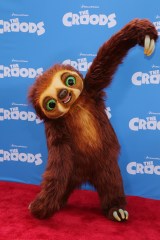A baby sloth in Costa Rica
A new animated film, opening this weekend, marks a hugely significant moment in modern pop culture. The Croods, a comedy about the travails of a Paleolithic family, features a cuddly pet sloth—yet another (very) slow but sure step in the sloth’s path to complete world domination.
The evidence is incontrovertible. The Google trends graph of searches for the term “sloth” was once a series of modest peaks and valleys, reflecting the fluctuating interest in the animal (or deadly sin). Then everything changed. Interest now is historically high; earlier this week, BuzzFeed published its epic list of the 25 Greatest Sloths the Internet Has Ever Seen.
Domination in action at The Croods premiere:

(VIDEO: White Lion Cub and Cute Dog Become BFFs)
While unimaginable today, there actually was a time when sloths were not cute. In 1985, the most significant sloth was this scary-looking character from a popular kid’s movie .
[youtube=http://www.youtube.com/watch?v=QWr30uoSCrw]
With Ice Age movies, the first of which came out in 2002, the primary pop-culture association shifted to an actual sloth — a prehistoric ground sloth named Sid. Voiced by John Leguizamo, he is one of the franchise’s central characters, but he’s not very huggable.
[youtube=http://www.youtube.com/watch?v=AMRHiz2r1UU]
So what happened?
The event that most people associate with the explosive popularity of sloths was the January 2012 appearance of actress (and avowed sloth lover) Kristen Bell on Ellen DeGeneres’ popular daytime talk show. Bell’s endearing meltdown (recounting the story of her boyfriend’s best-ever birthday gift) sent interest in tree-hanging cuteness to new highs—as evidenced on the Google graph.
[youtube=http://www.youtube.com/watch?v=t5jw3T3Jy70]
However, intrepid Internet sleuthing turns up a significant moment that took place a few months earlier. It seems in May 2o11, someone posted on YouTube a clip showing a sloth crossing a road to “I Believe I Can Fly” — subsequently watched by more than 7 million people.
[youtube=http://www.youtube.com/watch?v=ba7rRfKIHxU]
But, these events give us an incomplete picture.
(VIDEO: Baby Meerkats and Tigers, Oh My!)
To find the full story, we went to a real expert: Lucy Cooke, founder of the Sloth Appreciation Society, author of the new book A Little Book of Sloth (Mar. 5) and the woman whose website reminds visitors that The Atlantic dubbed her “the Steven Spielberg of sloth filmmaking.” (Evidence below.) She’s also behind Animal Planet’s Too Cute! Baby Sloths and has lent her expertise (and animal connections) to Vice’s The Cute Show and an upcoming Animal Planet sloth-centric series airing this fall. (She’s also helped create an as soon-to-be-released adopt-a-sloth app she hopes will educate those wanting to adopt sloths as pets — which is a major no-no.)
Cooke has a zoology background and says she has always loved underdog animals; the sloth was a natural object for her affection. She visited a sloth sanctuary in 2010—and that moment turned into what we will dub Sloth Lift-Off, day one in cute-sloth history. “The sloth really is the most misunderstood animal out there, having been named after one of the seven deadly sins,” she says. “The sloth seemed like it needed somebody to battle its cause.”
She does the usual zoologist work of educating sloth fans about the animals—which she says are naturally friendly, especially the three-fingered type. (More fun facts: sloths are physiologically built to hug, are smarter than you think, go to the sloth-bathroom only once a week, and only spend about six seconds at a time mating.)
But it turns out there’s a reason why a serious animal-lover like Cooke would spend so much time talking about what is a seemingly frivolous subject: popular animals get more money for their conservation. Five hundred times more funding goes to so-called “charismatic megafauna”—the bigger animals we think are cute or human-like or smart, like whales and elephants and tigers—than goes to endangered amphibians that may need it more, Cooke says. So she set out on a mission to make the world think sloths are awesome. “Conservation isn’t immune to the vagaries of fashion,” she says. “That’s why I do what I do.”
Obviously, she has succeeded. (Perhaps more than anyone has succeeded at anything. Ever.)
But Cooke says her work is not yet done. We think sloths are cute now, but we have not yet allowed them to fully infiltrate our minds—though we’ll be better off once we realize that resistance is futile. “They have a terrific message for us humans,” Cooke says, “and that is to slow down.”
[youtube=http://www.youtube.com/watch?v=J8b5v4USEWY]

